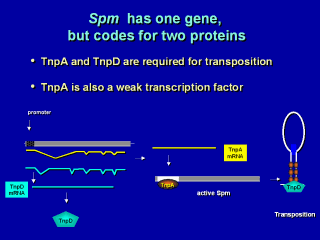| front |1 |2 |3 |4 |5 |6 |7 |8 |9 |10 |11 |12 |13 |14 |15 |16 |17 |18 |19 |20 |21 |22 |23 |24 |25 |26 |27 |28 |29 |30 |31 |32 |33 |review |
 |
Our laboratory cloned the Spm element some
years ago and we have explored the molecular basis of Spm inactivation and
reactivation. We’ve done this genetically in maize and we’ve used
reconstructed transgenic systems with introduced cloned element-encoded
genes and Spm promoter-reporter gene fusions. The essential findings are
these: 1. When the element is inactive, its promoter sequence is methylated. 2. The heritability of the inactive or silenced state is correlated with the methylation level of a downstream, very GC-rich seqence. 3. The promoter is rapidly methylated in transgenic plants, but only if it contains the GC-rich downstream sequence. 4. The element encodes two proteins that are necessary for transposition and one of these, TnpA, is both a transposition protein and a regulator. 5. TnpA binds to multiple sites present in both direct and inverted orientations at both element ends. 6. TnpA can reactivate a silenced, methylated element both transiently and heritably, identifying it a sequence-specific epigenetic regulatory protein. |